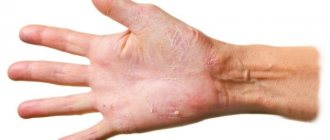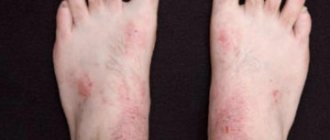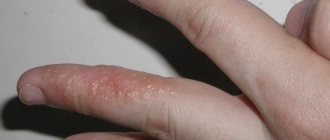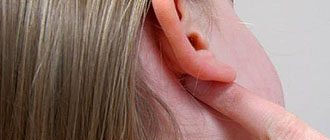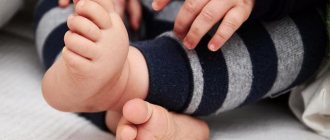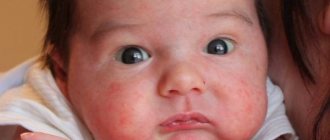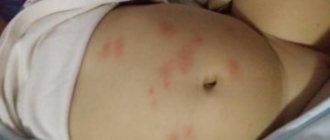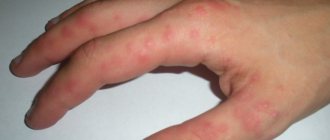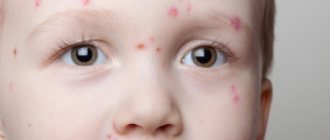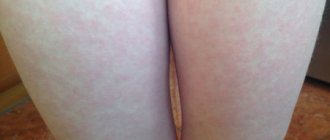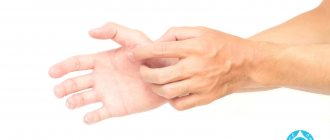Various types of rashes can sometimes appear on any part of the body, both an adult and a child. Most often, they do not affect the torso or face, as many believe, but the arms. While this symptom does not pose any particular danger in older patients, this cannot be said for children. A rather alarming sign, as doctors note, is when a rash on the palms of a child itches, bubbles and takes on various forms. This sign indicates the development of some kind of illness in the baby’s body, and parents should immediately show the baby to the doctor.
Rash on palms - symptoms
A rash on the palms of your hands will look and feel different depending on what is causing it. Most rashes appear inflamed and cause pain or itching. They may appear red on light skin, and grey, purple or dark brown on dark skin. Some rashes may also appear as blisters or peeling. A rash on the palm may cause discomfort when squeezing the hand or irritation when a person touches certain substances. Frequent hand washing can dry out your skin further.
Allergy
A rash on the palms and feet of a child and an adult often occurs due to allergies, which can appear as a result of interaction with various substances, in particular the following:
- medications;
— chemicals;
- wool of some animals;
- house dust;
- some plants.
Under the influence of various types of allergens, small red rashes can form on the upper side of the palm, as well as many other parts of the body. At the same time, the skin begins to itch very much. Along with the rash, other signs of an allergy appear, for example, the following:
- runny nose;
- sneezing;
- cough;
- suffocation.
It is necessary to carry out diagnostics in order to promptly recognize allergies and begin treatment. A complex of therapy can only be selected by a qualified doctor.
Rash on palms - causes
Some possible causes of palm rashes include:
Eczema
Eczema, or atopic dermatitis, is a common condition that causes dry, sensitive skin. It usually affects young children, but can also occur in adults. Symptoms include:
- itching
- dry skin that may crack
- red patches on light skin and gray or purple patches on dark skin
Some forms of the disease are more common on the palms, such as dyshidrotic eczema. This type of eczema can cause small blisters on the arms, fingers, and palms.
Treatment for eczema depends on the severity of the condition. There are many moisturizers available for mild to moderate cases of the disease. In severe cases, corticosteroids and antihistamines may be required.
Contact dermatitis
Contact dermatitis is a skin condition that develops when the skin comes into contact with an irritant or allergen. Many different substances can cause contact dermatitis, including:
- nickel
- latex
- poison ivy
When the skin comes into contact with something, the body perceives it as dangerous and this can lead to a rash. This rash causes the following symptoms:
- blisters
- itching
- pain
The skin may also be dry and, in severe cases, cracked. Because hands come into contact with many substances every day, they are a common place where contact dermatitis can develop.
The main treatment is to identify and avoid triggers for the condition. A doctor may do a test to determine what substance is causing the reaction. Some people may benefit from moisturizers or corticosteroids.
Hives
Hives are raised, red welts. They cause itching and can appear anywhere on the body, including the palms of the hands. An allergic reaction to certain substances causes this condition. This could be food, medicine or pollen. However, they can also occur in response to infection or physical irritants such as heat or sun exposure. Most cases of hives are acute and resolve when the trigger causing the reaction is no longer exposed. Antihistamines can reduce swelling and allergy symptoms. However, some people experience chronic hives.
Disease of the hands, feet and mouth (enteroviral vesicular stomatitis)
The virus causes enteroviral vesicular stomatitis. It most often occurs in children under 5 years of age, but can also occur in adults. Symptoms include:
- fever
- a sore throat
- a rash on the arms and legs consisting of painful blisters
- headache
- mouth ulcers
- loss of appetite
This disease is sometimes confused with aphthous fever (epizootic stomatitis). However, it is found only in livestock and is not found in humans.
Usually hand, foot and mouth diseases are not serious illnesses and go away without treatment in 7-10 days. At the same time, pain medications can relieve symptoms. However, this disease is contagious and spreads easily. Hand hygiene and avoiding close contact with other people can prevent the spread of the virus.
Fungal infection
Ringworm is a type of fungal infection that affects the hands. Ringworm is contagious, so touching other areas of the body affected by ringworm can lead to infection on the palms of your hands. Symptoms include:
- a small rash on the arms that gradually becomes larger
- itching
- peeling skin
Ringworm can be treated with creams. Your dermatologist may recommend a topical antifungal agent. If the infection persists or is severe, your doctor may prescribe systemic drug treatment.
Avoid touching other parts of the body and avoid contact with other people, as this can spread the infection.
Palmoplantar psoriasis
Palmoplantar (palm-plantar) psoriasis is an inflammatory disease that is accompanied by the appearance of red, scaly patches on the palms of the hands and soles of the feet. This is an autoimmune condition that occurs when new cells grow too quickly. Symptoms of psoriasis include:
- red, scaly patches of skin
- itching
- pain
- cracked skin that may bleed
Psoriasis can also affect the fingernails and toenails and may include pustules.
There is no cure for psoriasis, but there are treatments that can relieve symptoms:
- moisturizing steroid creams
- ultraviolet light therapy
- drugs to suppress the immune system, such as cyclosporine
Treatment
First of all, it is necessary to perform a diagnostic examination, identifying the causes that provoked an acute allergic reaction. After identifying the allergen, a course of treatment is prescribed, which is aimed at relieving allergic symptoms and preventing possible relapses.
- In the case where the causes of negative manifestations arise from food, the doctor prescribes a hypoallergenic diet. In addition, if a severe reaction develops, infusion therapy is recommended to remove toxic substances from the blood;
- To relieve allergic manifestations, a number of long-acting antihistamines are first prescribed. Recently, treatment most often uses third-generation drugs: Loratadine, Fenistil, etc. These drugs have a minimal number of side effects and do not have a sedative effect on the nervous system. This is especially important when treating a child;
- in case of severe development of an allergic reaction, treatment involves the use of hormonal drugs orally and for external use. As a rule, the ointment is applied directly to the palm itself in a very thin layer. The most effective use of external preparations such as Gistan, Fenistil-gel, Desitin. These drugs effectively relieve skin manifestations in the form of inflammation, redness, itching and are approved for use even for children;
- in particularly difficult cases, the allergic process may be accompanied by a suppurative process as a result of pathogenic microflora entering the wound surface. In this case, antibiotic therapy with simultaneous blocking of the inflammatory process is recommended. To do this, you can use ichthyol and Vishnevsky ointment.
It is important to remember that self-treatment of allergies on the surface of the hands is strictly prohibited. All therapeutic measures are carried out only after the appointment of the attending physician. This is due, first of all, to the individual sensitivity of the body and it is likely that medications for an adult patient are not suitable for treating a child. Therefore, the dosage and choice of antihistamines depends on the age of the patient and the state of the immune system.
Home care
Treatment methods depend on the underlying cause. For example, if you have a fungal infection, you shouldn't touch the rash or share personal items with other people. Antifungal creams will help treat this condition.
For allergic reactions, you may need to make diet and lifestyle changes to avoid triggers.
For dry skin, eczema and contact dermatitis, several remedies can be used, including:
- warm shower or bath
- using mild, non-irritating detergents
- Regular application of protective cream
- moisturizing after swimming, showering or washing hands
- putting on cotton gloves at night
Prevention measures
To prevent relapses - the return of the rash after treatment - it is necessary to follow preventive measures. It is important to prevent excessive sweating, dry hands, and eliminate the negative effects of toxic substances. To do this, when contacting cold, hot water, cleaning agents, detergents, it is recommended to use latex gloves.
Interesting! Latex is a highly allergenic material, so allergies are often noticed due to the use of rubber gloves. To prevent an allergic reaction, it is necessary to wear cotton gloves under rubber products.
To avoid irritation, you should thoroughly rinse off the soap after washing your hands, and wash only with warm water. Hand care is mandatory: the use of moisturizing and regenerating creams has a positive effect on the restoration of the skin on the palms. If the skin is clean and healthy, pathogenic microorganisms will not be able to penetrate, therefore, a rash will not appear.
Article on the topic: Allergic rhinitis - the best treatment methods
When to see a doctor
You can consult a doctor to determine the cause of the rash on your palms. Your doctor will help you identify the trigger and recommend treatment. It's also important to see a doctor if you have ringworm that doesn't respond to treatment, or if the rash shows signs of a bacterial infection. Symptoms of a bacterial skin infection include:
- pus
- edema
- feeling warm to the touch
- fever
People with hives or allergies should go to the emergency room immediately if they have trouble breathing.
Factors that provoke rash
The causes of rashes on the palms and soles of a child and an adult can be very different. Among the most likely factors are the following:
- infectious diseases;
- allergies;
- damage by parasites;
- inflammatory processes;
- vascular diseases.
Infectious diseases often spread to the entire body, including the feet and palms. Such diseases include rubella, chickenpox, measles, meningococcal infection and many others.
The cause of a rash on the palms can be allergic reactions, since the lesion often occurs at the site of contact with the allergen. The substance can enter the body through food, causing a rash to spread throughout the body.
The inflammatory process can manifest itself as subsequent suppuration on the skin of the feet and palms, as well as subsequent opening of the rash. This happens when an infection is associated with a skin rash.
Among parasitic infections of the hands, the most common disease is scabies. When it occurs, the space between the fingers on the palms is affected, and a characteristic itching occurs.
Diseases of internal organs
Disturbances in the functioning of the digestive system can provoke the appearance of such an unpleasant symptom as rashes on the palms. Functional failures can lead to the fact that decay products and toxins leave the body not naturally with feces and urine, but through the skin. Watery pimples on the palms can be a symptom of gastritis, dysbacteriosis, and pancreatic diseases.
In some cases, rashes occur due to an unhealthy diet. An unbalanced diet, abuse of processed foods, fatty, sweet and salty foods can also cause the formation of small formations on the palms.
Other causes of rashes
The cause of rashes is often infectious diseases. Among the most dangerous and common are measles, rubella, chickenpox, and scabies. With these pathologies, a rash may appear not only on the palms and soles, but throughout the body. Every parent needs to be able to distinguish the manifestations on the skin of infections in order to take timely measures to eliminate the disease.
- always accompanied by high body temperature, a rash appears on the entire surface of the skin, in any location.
- It also spreads throughout the body, but differs from measles in that not red spots, but bubbles appear on the surface of the dermis.
- b according to the localization of rashes, which most often appear in the abdomen, thighs, and palms. In this case, the rash has the character of small red spots. They do not turn into blisters and do not cause severe discomfort, unlike chickenpox and scabies, when the child is constantly itching.
- is a disease that manifests itself as a small, unpleasant rash in areas where there are folds, for example, the armpits, between the fingers, and in the genital area. Characterized by constant itching and burning. It is contagious.
In addition to infections, a factor affecting the condition of the skin is a banal failure to comply with the rules of personal hygiene. A parent can forget to wash their child’s hands just once after a walk and, as a result, get rashes all over their body. On the street there are many factors that easily lead to the development of infections and pathologies. You should be especially careful in the summer, when children actively play in the sandbox and with various play items (balls, crayons, jump ropes, etc.)
To be 100% sure that the expected diagnosis is correct, you should definitely contact your pediatrician. It will help you cope with the pathology in the shortest possible time. In addition, only an experienced specialist will be able to make a true diagnosis during examination, which will facilitate and speed up treatment.
A rash on the palms and soles of the feet can occur in both adults and children. It causes a lot of inconvenience and various concerns, since this is how many diseases make themselves known. These could be infectious diseases, allergic reactions, poisoning and much more.
Of course, a rash on a child’s palms may simply mean poor hygiene. But it is also possible to develop a more serious disease. Therefore, for any type of rash, you should consult a specialist.
The rash can affect almost any part of the body. But most often it can be seen on the face and hands. The rash on the palms and feet can have different shapes, colors and degrees of manifestation, depending on the reason for which it arose.
